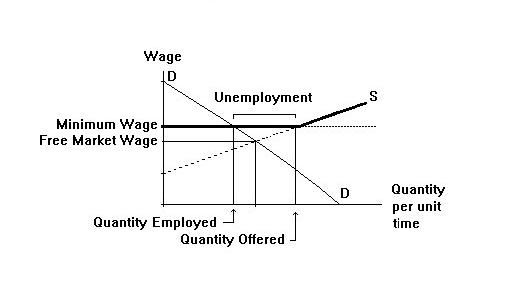
True or False?
The correct answer is true. The government can be viewed as imposing a new horizontal supply curve at the level of the minimum wage, saying in effect that nobody is permitted to sell their labor at less than this wage. The quantity of labor purchased in the market will then be determined by the intersection of this new horizontal supply curve with the market demand curve. The wage is an equilibrium wage in the sense that, once established, it will not change (unless the law is broken). Of course, it is not the free market equilibrium wage. Note here that the tools of supply and demand are very flexible in their application.
The situation is shown in the figure below. Less workers will be employed than before the minimum wage was imposed. Since the quantity of labor workers supply will be greater than the quantity employed, workers will be looking for jobs and unable to find them. There will be downward market pressure on the wage rate, but wages cannot fall because it is illegal to pay less than the minimum wage. We must always be careful to make a distinction between the price that rules in the presence of government policy and the market price that would rule in its absence.

Minimum wages are often advocated as a means to help poor workers. In this respect it should be noted that anyone whose skills cannot produce a flow of output equal to the minimum wage will never be able to find employment.